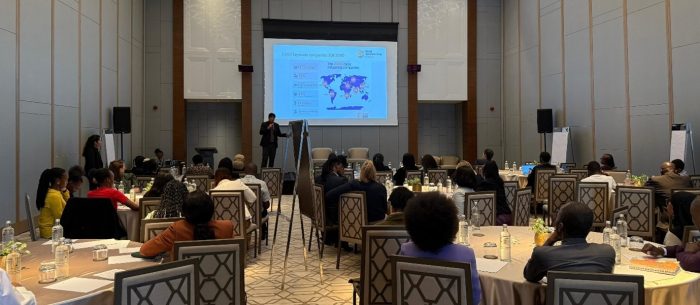Parallel Session 4 – Understanding, assessing and driving action towards a more resilient and sustainable urban future
The session aimed to raise awareness on the roles of corporations in achieving the SDGs, especially in the context of the urban environment, while also learning about the context of Nairobi and Kenya, including its most pertinent urban issues and how stakeholders in the country sees the roles of companies in addressing them. It does so by first presenting the initial findings of the 2024 Urban Benchmark, before engaging Kenyan stakeholders in an informal discussion about their priority urban issues in Nairobi, and beyond. Further, the session also sought to identify potential collaboration opportunities, as well avenues to further engagement with companies and other stakeholders, to enhance companies’ participation in advancing the SDGs.
Discussion points and summaries
While fully acknowledging the role of governments, and local governments as the leading actors of urban development and planning globally, the opening presentation of this session also highlighted a growing recognition of the significant role that companies can play in shaping urban environments globally. Some of the examples shared demonstrated how this influence often extends beyond the boundaries of companies’ original country of headquarters. It also touched on some examples of how today’s sustainability standards are derived from global agendas.

Opening presentation in session 4 set the scene with examples of the global reach of companies, and their growing role in shaping urban environments globally
In addition to constructing buildings and infrastructures, companies also play an increasingly important role at providing basic services in many urban environments – thereby contributing on whether the urban areas that they are servicing are inclusive, resilient and healthy. The multi-country, and sometimes global scale of companies’ operations gives rise to the question of the accountabilities that businesses should have on the impact of their operations, as they shape urban environments, including within Nairobi itself and Kenya’s broader urban environments. The World Benchmarking Alliance’s Urban Benchmark tries to foment this discussion, by providing a baseline assessment of what companies are already doing in contributing to the health, inclusivity, and resilience of urban environments.
The presentation was followed by a roundtable session for Kenyan stakeholders; to identify the issues they see as a key priority in their urban environments, noting that while global agendas remain relevant in the local context, its prioritization should be defined by local stakeholders. This roundtable session revealed some pertinent key issues in Kenya’s urban development: capacity of urban governance, as well as coordination between public and private stakeholders remains one of the central issues in the discussion, along with pressures to existing infrastructure systems (water, waste, sanitation), traffic congestion, natural disasters (flooding), and inadequate housing standards – the latter three issues being driven by rapid urbanization in Kenya.
Several participants mentioned that the Kenyan government have in fact tried to step in and address some of these issues via programs such as the National Affordable Housing Project and its associated levies. Yet, the program also remained a controversial one, considering the lack of public consultation for the policy prior to its implementation. Regarding appropriate building standards, professional associations and CSOs have also stepped in to fill this gap through the development of Safari Green Building Index, as well as the recently published Healthy Home Guidelines – both of which also speaks to the realities of the construction and building industry in Kenya, and in turn, highlighted the necessity of adapting global standards and frameworks to the national and local contexts to be applicable.
Other than the above topics, several other cross-cutting topics were also raised, such as the issue around land use and development controls. The latter contributing to encroachment of urban areas to its surrounding agricultural/ rural areas, which could in turn adversely impacts the country’s food systems. Another cross-cutting issue that was discussed had been around Urban Governance, and the lack of standards around data governance that often prevents data exchanges between different government agencies, as well as the generally low number of building professionals relative to the number of issues around Kenya’s urban environments.
Key takeaways
- Global frameworks and standards will need to be adjusted to fit the realities on the ground. Taking the example of the building sector in Kenya, a significant portion of buildings in Kenya are in fact non-engineered buildings and wouldn’t therefore qualify for an international certification scheme. This, however, does not eliminate the need for standards and frameworks for healthy, sustainable buildings. As such there needs to be coordination between global and national, or local actors to ensure that standards are applicable to the context where it is to be implemented.
- Global issues remain relevant at the local level, but their prioritization remains dependent on the need of stakeholders on the ground. While Nairobi shares the same issues that other cities in rapidly urbanizing regions are also facing, different cultural, political, and environmental factors will give rise to additional nuances in an issue, and how it interacts with other related issues.